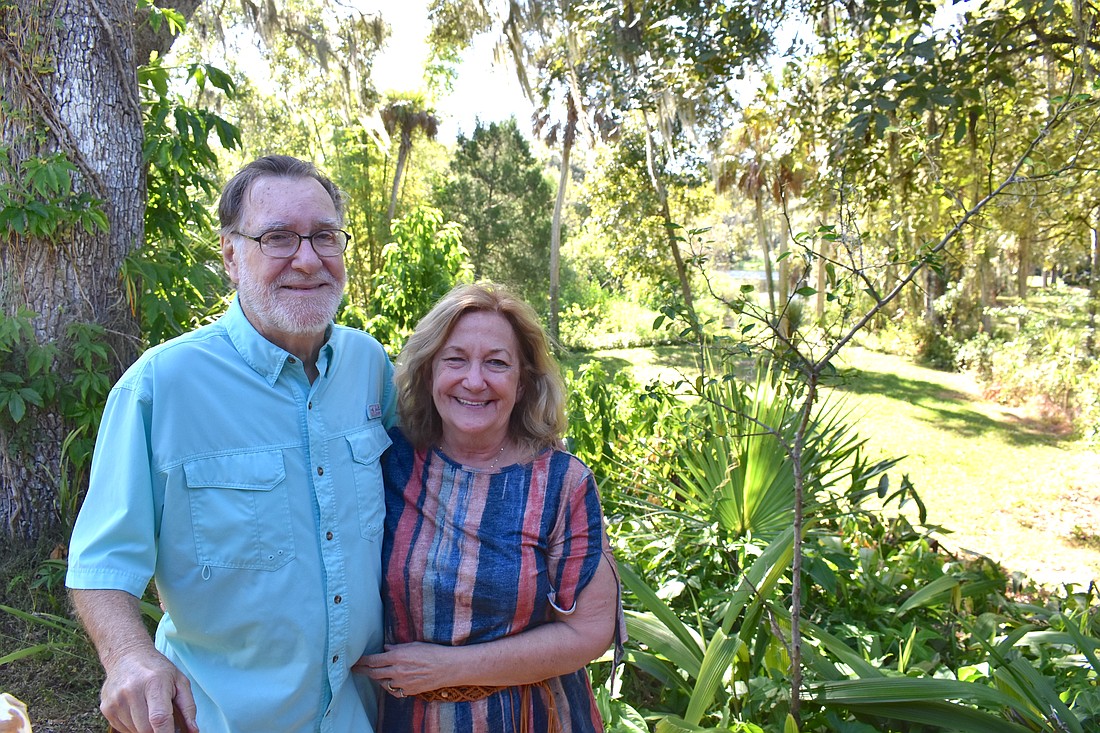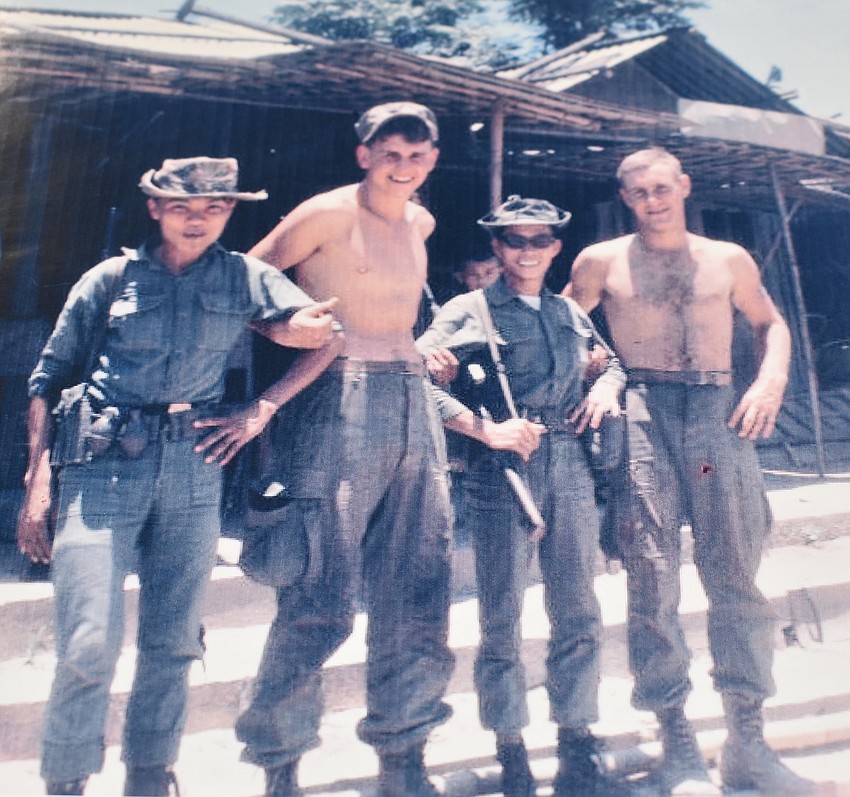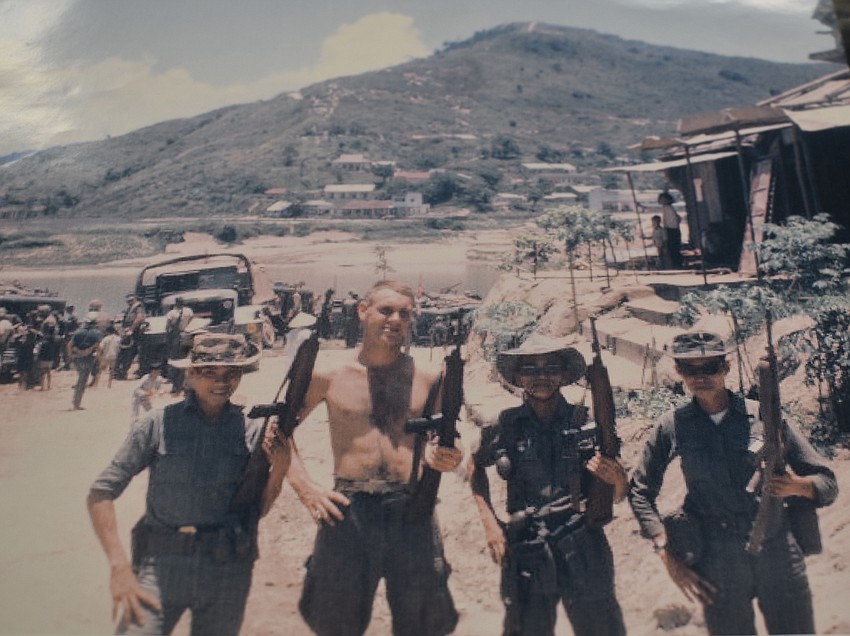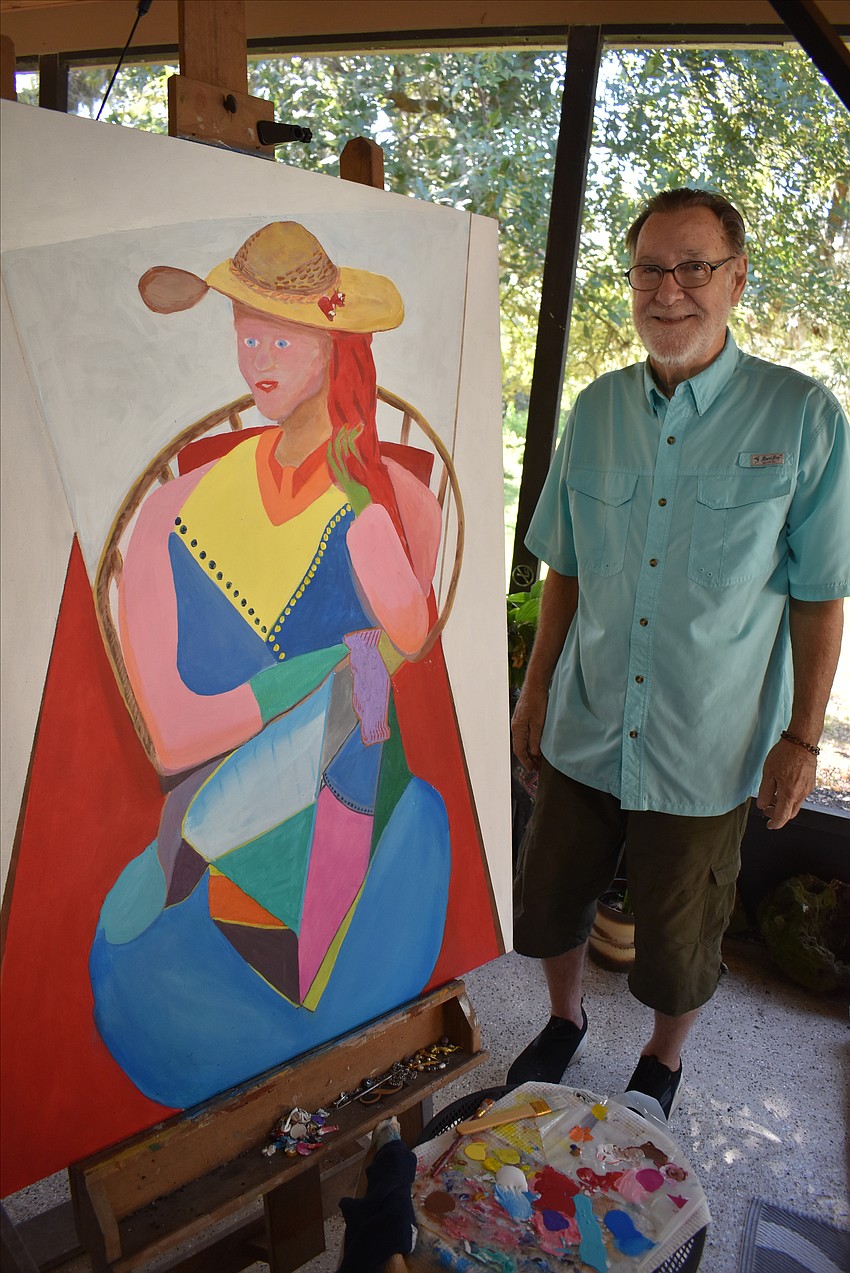- July 22, 2025
-
-
Loading

Loading

It is a peaceful setting, the Braden River rambling past the bottom of their yard along 71st Avenue Drive East, only a few football fields from the historic Linger Lodge.
Bob and Michele Bowermaster have lived there in East County since they had the place built in 1988, not long after Bob's 18 1/2-year career with the railroad ended because, as he puts it, "(Conrail) wanted to get rid of me."
The Bowermasters, who lived in Toledo, Ohio, never visited the site before buying, and only checked it out on maps. It struck a chord with him because there was water everywhere and he loves to fish.
Sitting on his lanai last week, Bob Bowermaster stood near a painting that he has been trying to finish. The portrait explodes with bright blues, reds and yellows, and the young woman, wearing a floppy sun hat, has a quizzical, and yet fun, look on her face. He calls the woman "Rose."
It is not bleak by any means, and Bob Bowermaster would be forgiven if his subject matter bordered more on the dark side.
Across the room, a wheelchair sits in a handy spot, alerting any visitor to the fact that Bob Bowermaster's life hasn't been all health and tranquility.
Not long after his 18th birthday, he was shipped to Da Nang, Vietnam with the U.S. Marines. His stories of his six months in combat are terrifying.
He seldom talks about those experiences for the simple reason that no one believes him.
"The guys you grew up with don't believe you," he said. "So I stopped (telling the stories). If you don't want to hear it, I won't tell it."
Heading into Veterans Day on Nov 11, Bowermaster agreed to reopen some old wounds.
He unbuttoned the top three buttons of his shirt, and pulled it back to show a deep scar in the right portion of his chest where he had been shot on July 4, 1967 at the Firebase Nông Sơn, a U.S. Marine Corps fire support base southwest of Da Nang in Quảng Nam Province.
Bowermaster, who was with 1st Platoon, Fox Company, was working a "listening post" in advance of the attack of an expected 400 enemy troops against American forces a third of that size. That post was located at the top of Nông Sơn Mountain, which was really more of a hill at 650 feet at its peak. The hill was deemed important because it stood adjacent to the Nông Sơn coal mine, the only such facility in the region.
His story began late on July 3.

He said his patrol was assigned to a bunker on the far side of the hill, which was mostly thick jungle. The bunker was built into a steep ledge and Bowermaster was concerned enemy forces could make their way through the jungle to the edge of the bunker and then have the Marines trapped.
"We asked our commanding officer to spray the jungle with flame," Bowermaster said, noting that it would allow the Marines to easily see if anyone was approaching once the vegetation was burned. "But they wouldn't, and I didn't want to get stuck in that bunker."
He accepted the listening post duty and went with two other Marines to an area just down from the hill's peak.
"We found a hole beneath some brush," he said. "We stayed there, and we heard a lot of noise, including cans and bottles rattling."
Bowermaster reported the noise and that they thought the enemy was nearby, but their warning wasn't heeded.
"Shortly after midnight, all hell broke loose," Bowermaster said. "It was chaotic They were right there."
The Americans only had about 40 soldiers at the top of the hill and the enemy was approaching from all directions in greater numbers.
Bowermaster saw enemy soldiers approaching the edge of the bunker, where the Marines had taken shelter.
"We started shooting them off the bunker," Bowermaster said of the enemy. "We shot one guy six times before he would fall."
But they kept coming, and even though they were "easy pickings," Bowermaster called for more ammunition as he was running out.
He felt a sudden jab in his chest.
"I screamed," he said. "I felt something hit me in the chest like a sledgehammer."
The two other Marines, who were new to the platoon, told him to "shut up because they will know where we are."
He couldn't talk, but he remembered thinking, "'I think they know."
The two new soldiers took off, and Bowermaster was left behind, on the ground, unable to move.

"I was never scared the whole time in Vietnam, I don't know why," he said. "Except for when I heard that sound of the air going in and out of my lung. It was like that dentist's tool you hear in the office. When I go to the dentist even today, that sound freaks me out, and they can't understand why."
He had his rifle, helmet, uniform and a flak jacket, but no first aid kit. He stuck his index finger into the hole in his chest so he could breathe out of his mouth.
"Out of the corner of my eye, I could see movement and this guy stuck a bayonet into me, just catching my side," Bowermaster said. "He looked like a 14-year-old boy, and he never pulled the trigger. He just backed off and left."
Moments later, Bowermaster was being dragged, his head bouncing up and down off the ground.
"I said, 'Hey guys, I am still alive,' thinking it was my guys."
It was the enemy.
After considerable commotion, during which time he lost consciousness, he opened his eyes to see his friend Thom Searfoss standing over him. Searfoss had earlier heard Bowermaster call for more ammunition on the radio and he came to help.
Searfoss asked if he was doing all right, but Bowermaster wasn't breathing. He pointed to his mouth and Searfoss immediately began mouth-to-mouth. Twice more, Bowermaster stopped breathing, and each time Searfoss performed mouth-to-mouth.
"Thom set me up a little, then dragged me to the back side of the road (where there were other Marines)," Bowermaster said. "The fighting was going on all the time."
The Marines knew Bowermaster couldn't move, so they put an AK-47, taken off a dead enemy soldier, between his feet and told him to "spray them," if he saw the enemy.
He said one enemy soldier burst into their area and pointed his pistol at a Marine sergeant there.
"He pulled the trigger, click," Bowermaster said. "It didn't go off. We shot him and that sergeant (Mike Byrd) still has that pistol."
Bowermaster looked up to see the sparks of a RPG-2 (hand-held antitank grenade launcher) and the rocket exploded right below him. The rocket injured Marines to his right and left and left shrapnel in his butt and back. Over the years, that injury led to seven back surgeries and testicular surgery.
"I still have shrapnel in my butt," he said.
He also was shot in the finger during that attack. Bowermaster received two Purple Hearts for the battle.
He estimated the attack lasted "an hour or so" until he saw a "puff plane," an American C-47 that was fitted with 7.62 mm mini-guns, which fired up to 6,000 rounds per minute. Soldiers began calling the plane "Puff the Magic Dragon."
The enemy forces retreated.
Records later showed that before the attack was repelled, 13 U.S, Marines were killed along with 42 enemy soldiers. The battle was recounted in the play, "The Battle at Nong Son," written by one of Bowermaster's fellow soldiers, Johnnie M. Clark.
Quoted in the non-fiction play was PFC Don Rouzan, who said of Bowermaster after he was shot, "Bob was hit bad and I knew it. He was calm and didn't panic a bit."
Searfoss also was quoted as saying, "It was good to see the sun come up. I had helped to put Bob Bowermaster on the medevac chopper. Jack Melton, too. What incredible Marines. What heroes. The stuff legends are made of. I wondered if anyone would ever know what kind of heroic Marines had been on this stinking hill on the 4th of July."
Helicopters couldn't arrive to fly out the wounded until the sun came up on July 4. Bowermaster was on the first helicopter out and the next time he woke up was on a cold hospital table in Da Nang. When he opened his eyes, he said a priest was hovering over his face.
"I said, 'Hey Father, I don't think I am going to need you today."
Besides the hole in his chest and finger, he had three shattered ribs and his lungs were full of blood.
He was put on the hospital ship, the USS Sanctuary, for the trip home. He almost died on the voyage back because he was having trouble coughing the blood up out of his lungs.
Although he planned to make a necklace out of the bullet they took out of his chest, he said someone stole it in the hospital. Back in the U.S., he was sent to the Great Lakes Naval Base hospital in Illinois for months of recovery.
He left the Marines as a sergeant in 1969, then worked in factories before his 18 1/2 years with the railroad.
Bowermaster was born in Toledo and adopted by Fred and Mary Bowermaster at 6 months. He said Mary Bowermaster had been adopted herself, riding the "Orphan Train" that ran from Maine to Minnesota between the mid-19th century and 1929. Abandoned children were put on the train and often claimed by farmers along the route who needed workers.
Mary Bowermaster served 10 years as a nun before working as a teacher and a librarian, among other jobs. Fred Bowermaster worked at the Erie Army Depot as a carpenter, building crates that were used to ship tanks and canons.
Although he said his parents were loving, they spent little time with him because they worked all the time.
By 16, Bowermaster said he was "trouble."
"I hated school and I had that itch," he said. "I couldn't settle down. My dad had bought me a red Chevy convertible. Why would you buy a kid like me a red convertible?"
He had friends and a cousin in the Marines, so he decided that would be his best move. His parents had to sign his papers because he was just 16, and he had to wait until he was 17 to go to Camp Pendleton for boot camp.

"The Marines looked like a home to me," he said. So on March 2, 1966, I was in boot camp. I had been a football player and wrestler, so I wasn't worried about them yelling at me. I figured they couldn't kill me, and they couldn't eat me, so what were they going to do?"
He knew nothing about Vietnam.
"I was 16," he said. "You don't pay attention to the news."
After boot camp, he started infantry training and met Searfoss, from Muncie, Indiana. They became quick friends and asked to be shipped together to their next base, Camp Courtney, in Okinawa, Japan.
"Okinawa had crystal clear water, it was so much fun," Bowermaster said.
Still, he and Searfoss, who now lives in Arlington, Washington, knew little about Vietnam. When they turned 18, they were shipped to Da Nang in March 1967.
"We got off the plane in Da Nang and the heat hit you like you were opening an oven," Bowermaster said. "You couldn't breathe, and we got there at night. I remember hearing mortars going off."
They saw a "puff" plane for the first time and he compared it to a laser light show over Da Nang.
"Every fifth bullet was a tracer," Bowermaster said. "They were being shot out so far it looked like red lights coming out of our airplanes."
Both he and Searfoss were assigned to the same platoon.
"We were assigned to the group that got all the (crap) jobs," Bowermaster said. "If there were 15 of them, and one of us, they would say, 'Go get 'em!' Those kind of jobs."
He said the first combat they were in, big bombs were hitting around them and they were using the craters formed for cover. He said they never really saw the enemy, and only shot in the direction of the enemy.
"We wondered if we were doing things right," he said. "Why did we do that? That seemed really stupid?"
He said seeing his fellow soldiers die was just part of the job.
"When they were gone, they were gone," he said. "After a few times, you didn't think about it."
These days, most of his thoughts about his service involve seeking some type of compensation for not being able to function in the workforce due to his injuries. He hired a lawyer earlier this year to help with his effort.
Michele says she has work not to say too much when he seeks compensation from various authorities. They have been married since 1982, and she said his battles with the Department of Veterans Affairs anger her.
"I try not to say much because I know it doesn't make it better," she said.
"I never have been paid any disability for my back," said Bowermaster, who said authorities never have recognized his shrapnel injuries.
Last week, he went to the VA Hospital to have bone marrow taken from his hip. He said he has low blood counts and he worries that Agent Orange might be taking effect. He said all his friends from the Marines, other than Searfoss, have died from Agent Orange.
Still, he says he would do it all over again.
"The Marine Corps was a home for me," he said. "I loved it, and I loved the discipline. I loved everything about it.